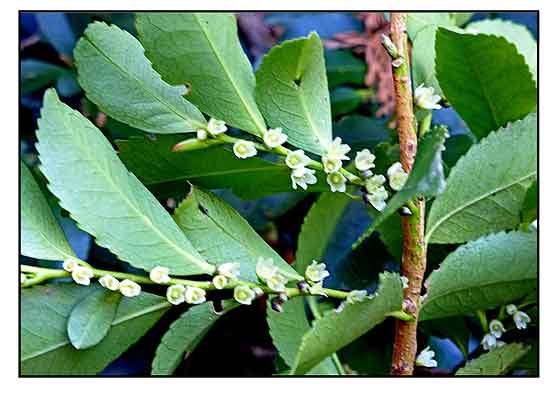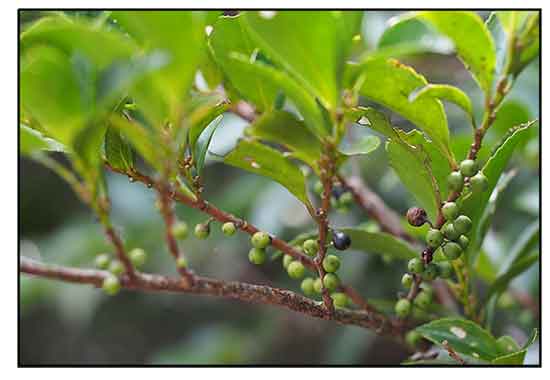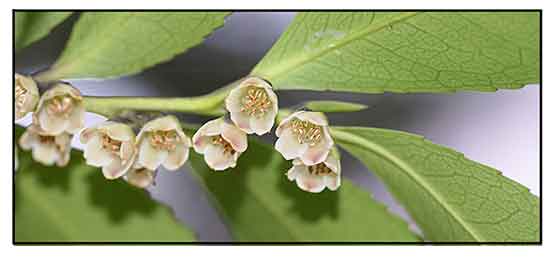Gen info
- Eurya is a genus of about 70 species of flowering plants in the family Pentaphylacaceae.
Eurya japonica, known as East Asian eurya, is a shrub in the genus.
- In Shinto, it is a sacred tree, whose leaves are used as
sacrificial offerings. (3)
 Botany Botany
• Shrubs 1-3.5 m tall. Young branches grayish brown to brown; current year branchlets yellowish green to pale brown, 2-ribbed, glabrous; terminal buds glabrous. Petiole 2-3 mm, glabrous; leaf blade obovate, obovate-elliptic, or oblong-elliptic, 3-7 × 1.5-3 cm, thickly leathery to leathery, abaxially pale green, adaxially dark green and shiny, both surfaces glabrous, midvein abaxially elevated and adaxially impressed, secondary veins 5-7 on each side of midvein, abaxially raised, and adaxially impressed, base cuneate, margin sparsely and obtusely serrate, apex obtuse, subrounded, or rarely acute and with an obtuse and sometimes retuse tip. Flowers axillary, solitary or to 3 in a cluster. Pedicel ca. 2 mm, glabrous. Male flowers: bracteoles suborbicular, ca. 0.5 mm, glabrous; sepals ovate to suborbicular, ca. 2 mm, glabrous, apex rounded and mucronate; petals oblong-obovate, ca. 4 mm; stamens 12-15; anthers not locellate; pistillode glabrous. Female flowers: bracteoles suborbicular, very small; sepals ovate, ca. 1.5 mm, glabrous; petals oblong, 2.5-3 mm; ovary globose, glabrous, 3-loculed; style ca. 1.5 mm, apically 3-lobed. Fruit globose, ca. 5 mm in diam. (Flora of China)
Distribution
- Native to the Philippines. (1)
- In mossy forests, exposed ridges and ravines. In Luzon, from Ilocos Norte to Sorsogon; in Mindanao, Davao; in Mindoro, Negros, Palawan. (1)
- Also native to China, Japan, Korea, Nansei-shoto, Vietnam. (2)
- Ornamental cultivation.
 Constituents Constituents
- Study of stems isolated 8,8′,7,2′-lignans, (+)-ovafolinin B-9′-O-β-d-glucopyranoside (1), (−)-ovafolinin B-9′-O-β-d-glucopyranoside (2), (+)-ovafolinin E-9′-O-β-d-glucopyranoside (3), and (−)-ovafolinin E-9′-O-β-d-glucopyranoside (4), two neolignans, eusiderin N (5) and (7S,8R)-3,5,5′-trimethoxy-4′,7-epoxy-8,3′-neolignan-9,9′-diol-4-O-β-d-xylopyranoside (6), and two new chromone glycosides, 5,7-dihydroxy-4H-chromen-4-one-3-O-β-d-glucopyranoside (7) and 5,7-dihydroxy-4H-chromen-4-one-3-O-β-d-xylopyranoside (8), together with 25 known compounds. (see study below) (4)
- GC-MS analysis of essential oils from flower and aerial parts yielded a total of 87 and 50 compounds
, respectively. Main compounds of flower oil were linalool (14.0%), (9Z)-tricosene (12.0%), and nonanal (7.4%). Aerial parts yielded main compounds of linalool (37.7%), α-terpineol (13.5%), and geraniol (9.6%). (see study below) (6)
- Study of male flowers isolated am acylated flavonoid glycoside, named euryanoside (1), together with known compounds, halleridone (4) and cornoside (1).
Structure of compound 1 was established as apigenin 5-O-α-L-rhamnopyranosyl-(1-->2)-(6"-O-acetyl)-ß-D-glucopyranoside. (9)
- Study of leaf extract for phenolic and flavonoid content yielded 26.31 mg gallic acid equivalents (GAE) / mg dry weight and 74.99 mg GAE/mg dry weight, respectively. (see study below) (11)
Properties
- Studies suggested antioxidant, anti-inflammatory, anti-dry eye, anti-diabetic, cosmeceutical, elastase and tyrosinase inhibitory, antibacterial properties.
Parts used
Stems, bark, leaves.
 Uses Uses
Edibility
- Leaves used as tea substitute or to adulterate China tea. (3)
Folkloric
- No reported folkloric medicinal use in the Philippines.
- In India, decoction of dried bark powder drunk as antidote against snake bits.
Also used for body ache, body swelling, boils, bone fracture, dental caries, diabetes, eczema, hypertension, paralysis. (10)
- In traditional Chinese medicine, used for treatment of fever, abdominal pain, and diarrhea.
Others
- Cosmetics: Extract used as cosmetic ingredient for skin conditioning use.
- Fodder: Leaves used as fodder.
- Wood: Used as fuelwood.
Studies
• Antioxidant / Anti-NO Production / Stems: Study of stems isolated four new 8,8′,7,2′-lignans, together with 25 known compounds. Compounds 1, 2, 12-20 and 29 demonstrated potent antioxidant activity (EC50 23.40 µM for 1) compared to positive control α-tocopherol (ED50 27.21 µM
). Compounds 1, 2, 7-9, 12-20, and 32 showed only weak anti-NO production activity compared to positive control quercetin. (see constituents above) (4)
• Anti-Inflammatory / Dry Eye Disease: Study evaluated the therapeutic efficacy of E. japonica extracts in dry eye disease (DED), using human corneal epithelial (HCE) cells and a mouse model of experimental dry eye (EDE). Eye drops consisting of BSS or 0.001%, 0.01%, and 0.1% EJ extracts were applied for treatment of EDE. Mice treated with EJ extracts in HCE cells effectively improved cell viability, ROS levels and mitochondrial function. Treatment with 0.01 and 0.1% extract showed significant decrease in ROS, TNF-α, IL-1ß, IP-10, and MIG levels compared with EDE or BSS groups. Improvement in all clinical parameters was observed. EJE could decrease cytotoxicity and ROS production in HCE cells, reduce oxidative damage and inflammation, and improved clinical signs of EDE. Results suggest potential as adjunctive therapy for DED. (5)
• Essential Oil Odor / Aerial Parts: Study evaluated the chemical compositions of essential oils from flowers and aerial parts (leaf and branch). GC-olfactory (GC-O) analysis oil from flower and aerial parts 13 and 8 aroma-active compounds, respectively. Results showed nonanal and eugenol impart the sweet, citrus, and spicy odor of flower oil, while (E)-ß-damascenone and (E)-ß-ionone contribute the floral and sweet odor of the oil from the aerial parts. (see constituents above) (6)
• Anti-Diabetic / Leaves: Study evaluated the anti-diabetic activity of methanol leaf extract and EJ-1 fraction of Eurya japonica in streptozotocin-induced diabetes in mice. Extract at 300 mg/kbw and 600 mg/kbw elicited significant reduction (p<0.001) in blood glucose level at 56.56% and 60.80%, respectively, comparable to glibenclamide (10 mg/kbw) at 60.82%. Histopathological study showed amelioration of STZ-induced histological damage of islets of Langerhans in pancreas and hepatocytes in the liver. (7)
• Antibacterial / Leaves: Study of leaves of Eurya japonica showed antibacterial activity against Gram(+) Staphylococcus aureus and Gram(-) Escherichia col, Klebsiella pneumonia and Pseudomonas species using disc diffusion method. (8)
• Antioxidant / Leaves: Study evaluated the antioxidant activity of leaf extract of Eurya japonica and estimated its phenolic and flavonoid content. Results showed DPPH EC50 value of 32.30 mg/ml and reducing capacity of 173.70. A positive relationship was observed between total phenolic and flavonoid content with antioxidant activity of the leaf extract. (see constituents above) (11)
• Elastase Inhibitory / Leaves: In an invitro screening study of Jeju island plant extracts for cosmetic ingredients, Eurya japonica leaf extract showed 19.4% elastase inhibition (1 mg/ml) and 9.0% tyrosinase inhibition (300 µg/mL). (12)
Availability
Wild-crafted.
Ornamental cultivation.
|

![]()



 Botany
Botany Constituents
Constituents
